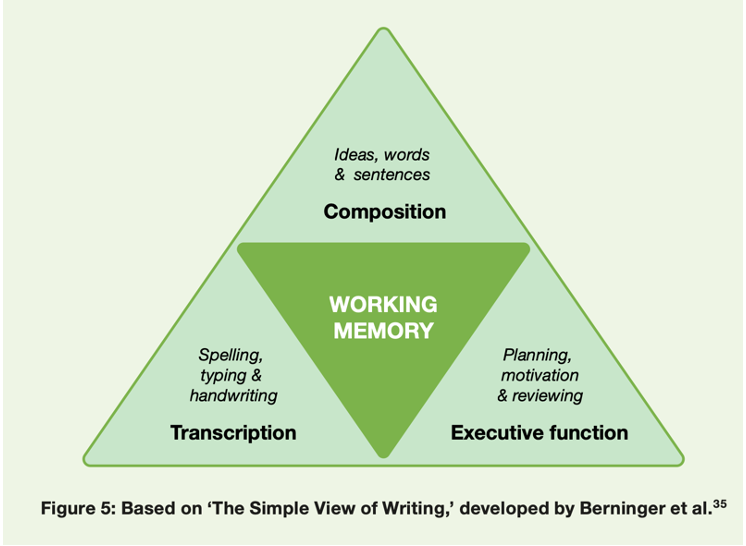After some grim national writing results last year, and lots of conversations with school leaders about their post-Covid teaching and learning priorities, writing is high on many schools’ priority list.
Common issues that have been raised to me by school colleagues are wide ranging, from issues with spelling, to extended writing, problematic writing assessments, and much more.
Perhaps the most common complaint and challenge I hear is the statement: ‘my pupils lack writing stamina’.
The problem is that I am not sure many teachers agree on what they mean by ‘writing stamina’, never mind making teaching decisions to address the seeming struggle.
What do we mean by ‘writing stamina’ anyway?
For many teachers, a lack of writing stamina characterises an inability to write independently for a sustained period. And yet, it probably characterises a broader range of behaviours that attend writing (and learning). Just a sample of these could include:
- Limited handwriting fluency. For younger pupils in particular the motor skills required of extended writing is hard work. As a result, their handwriting quality can quickly slip. For older pupils too, the effort and attention on handwriting can wane.
- Running dry of ideas. For many pupils, with an urge to get going with a tricky writing task, they rush into the act. They plan sparingly. As a result, their initial enthusiasm is dimmed and they run out of creative ideas, or deep knowledge of the topic at hand.
- Errors increase in pupils extended writing. Pupils embark on their writing, but they lack the ability and stamina to edit and revise what they have written. As a result, their writing is error strewn and apparently maxed out of all stamina.
- Motivation is low to keep going with a writing task. Every teacher has battled with the reality of pupils claiming, ‘I’ve finished!’ in a matter of minutes, or gnashed their teeth as a pupil has plonked their head on the desk during the act of writing.
The notion that pupils are lacking in ‘writing stamina’ could account for an array of problematic causes. If we do not decipher the underlying causes, then we risk not finding solutions for pupils’ struggles. For example, we need to better discriminate emotional factors, such as effort and motivation, from knowledge-related factors such as having too little background knowledge or being unclear how to plan effectively.
Diagnosing ‘writing stamina’ struggles with the ‘Simple View of Writing’
A helpful model to frame the complex challenge of writing, and writing stamina, is the ‘Simple View of Writing’. See this adapted graphic from the EEF guidance report:

Graphic taken from ‘Improving literacy in Secondary Schools’, by the Education Endowment Foundation
The ‘Simple View’ does what it says on the tin. It helps to simply and chunk down the complex act of writing. It can help better categorise the issue of writing stamina. For instance:
- Transcription and writing stamina. Pupils lack fluency and automaticity in their handwriting. Additionally, gaps in their spelling knowledge are drawing on precious mental energy that pupils need to reserve for selecting words, composing sentences and more.
- Composition and writing stamina. Pupils lack a breath and depth of vocabulary to draw upon to express their ideas. They struggle to deploy academic language or link their ideas with sentence signposts, such as because, however, and in contrast. Their sentences are either truncated and too simple, or they run on and on, with too little sense. Short of ideas, pupils struggle with most forms of extended writing.
- Executive function and writing stamina. Pupils don’t plan or monitor their writing to make quality improvements. Their sense of what a ‘good effort’ would compose of is lacking. They lack the habits of the writing process – such as carefully editing and making additional revisions to what they have written – and give up too easily. They don’t enjoy writing, nor feel they are being successful, so they just give up.
Like any model that tries to make sense of complex learning, the ‘Simple View’ has its limits. Of course, these factors interact, the boundaries are blurred, and not every issue is adequately addressed. And yet, it helps us get one step closer to a shared understanding of the apparent struggle with ‘writing stamina’. That shared understanding then brings us closer to addressing the issue.
For three different pupils, you might diagnose a different challenge:
- Janet has issues weak spelling (transcription), a lack of knowledge of the task and the topic they need to write about (composition), and poor editing (exec function).
- James exhibits low effort and motivation for most writing tasks (exec function).
- Jamila tries hard, has some good ideas, but her hard to read run-on sentences (composition) and non-existent planning keeps tripping her up (exec function).
There are no quick fixes for these struggles, for pupils like Janet, James, and Jamila, but a better understanding of their writing stamina problems poses a useful starting point.
…
Related reading:
I have recently written a few blogs that relate to the issue, and solutions, for the struggle with writing stamina:
- Write Less; Read More. Fundamentally, we may be undertaking too many extended writing tasks that don’t hone pupils’ skills nor build their motivation. READ MORE HERE.
- The challenge of editing writing. Some pupils lack the ‘stamina’ to edit because they don’t know how to do it, and the task is simple too big and complex. READ MORE HERE.
- ‘The Not-So-Simple View of Writing in Struggling Writers/Readers‘. This research study offered challenges and updates to Berninger’s Simple View model, if you want to get into the weeds of the research evidence. READ MORE HERE.
All of these topics and more are addressed in my book, ‘Closing the Writing Gap’ – see HERE and HERE
[Image: ‘A boy wearing long sleeve sweater resting head on a desk‘]






Comments